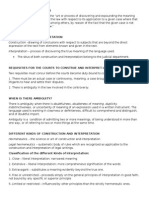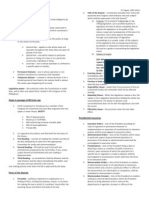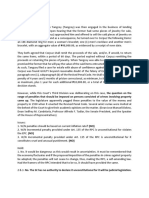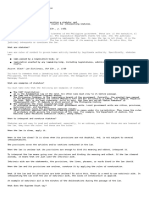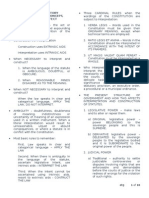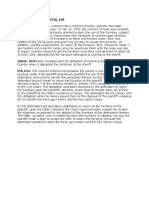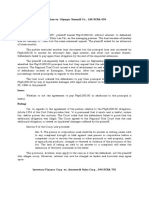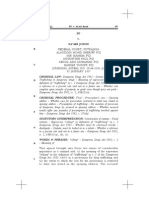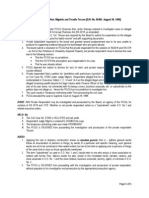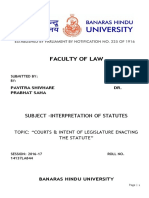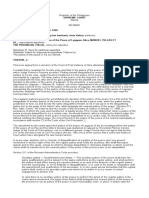Statutory Construction (A Compendium From The Books of Rodriguez, Martin and Agpalo)
Statutory Construction (A Compendium From The Books of Rodriguez, Martin and Agpalo)
Uploaded by
Jay-r Mercado ValenciaCopyright:
Available Formats
Statutory Construction (A Compendium From The Books of Rodriguez, Martin and Agpalo)
Statutory Construction (A Compendium From The Books of Rodriguez, Martin and Agpalo)
Uploaded by
Jay-r Mercado ValenciaOriginal Description:
Original Title
Copyright
Available Formats
Share this document
Did you find this document useful?
Is this content inappropriate?
Copyright:
Available Formats
Statutory Construction (A Compendium From The Books of Rodriguez, Martin and Agpalo)
Statutory Construction (A Compendium From The Books of Rodriguez, Martin and Agpalo)
Uploaded by
Jay-r Mercado ValenciaCopyright:
Available Formats
1
STATUTORY CONSTRUCTION
(A Compendium from the books of Rodriguez, Martin and Agpalo)
Introduction
CONCEPTS AND GENERAL PRINCIPLES
I. Statutory Construction
- Statutory construction is the art or process of discovering and expounding the meaning
and intention of the authors of the law with respect to its application in a given case,
where the intention is rendered is doubtful by reason of the fact that the given case is not
explicitly provided for in the law (Caltex vs. Palomar 18 SCRA 247)
- It is the art of seeking the intention of the authors of the legislature in creating a statute
and applying it to given a state of facts.
- It is the art or process of ascertaining the intention of the law-making body to resolve
ambiguity in the law or its part.
Note: Only statutes with ambiguous or doubtful meaning may be the subject of Statutory
Construction
Ambiguity
- Is the doubtfulness, doubleness, indistinctness, non-singularity or uncertainty of meaning
of an expression used in written instrument (Black’s Law Dictionary).
- Also refers to vagueness or obscurity of the true sense or meaning of an expression, text
or language used in a statute.
II. Legal Hermeneutics
- It is the branch of science that establishes the principles and rules of interpretation and
construction of written laws.
- Branch of Jurisprudence
III. Exegesis
- The application of the principles and rules established by legal hermeneutics.
Statutory Construction Legal Hermeneutics Exegesis
Seeking the intention using Establish the principles and Application of principles
the principles/procedures to rules: knowing the and rules
be able to interpret or procedures
construct
Goal: To ascertain the intention of the authors of the law.
Cardinal Rule on Statutory Construction
- Achieve the goal of the law
- Ascertain the intention of the frames of the law
Formula:
Facts + Law = Decision
(F + L = D)
ATTY. NESTOR MONDOK
Professor, Statutory Construction
COLLEGE OF LAW
UNIVERSITY OF THE CORDILLERAS
2
Chapter 1
STATUTE, LAWS, BILLS
Statute – is an Act of the legislature as an organized body; it is the Written will of the legislature,
Expressed according to the form necessary to constitute it a law of the state and Rendered
authentic by certain prescribed forms and solemnities. (AWER)
Law – a rule of conduct or order of sequence which any being will not, ought not or cannot
deviate. Elements: certain kinds of force, deviation and consequence.
Bill – is a proposed law; draft of a law submitted to the consideration of the legislative body for
adoption.
Kinds of Bills
1. Appropriation Bill – the primary and specific purpose is to authorize the release of funds
from the public treasury.
2. Revenue Bill – one that levies taxes and raises funds for the government.
3. Tariff Bill – one that specifies the rates or duties to be impose on imported articles.
4. Bill Increasing Public Debt – one that authorizes the government to borrow money, either
by borrowing from external sources or offering bonds for public subscriptions.
5. Bill of Local Application – one which is local in character like the creation of new town,
city or province.
6. Private Bill – one that will not operate directly for the public good but calculate to serve
good will (e.g. bills granting honorary membership).
How laws are made: (Procedures)
o Research
First Reading – any member of either house may present a bill, signed by him and
reference to the proper committee; principal author may propose the inclusion; the bill is
read by its title number and name/s of author/s
o Referral to the Appropriate Committee – if disapproved, the bill dies a natural
death unless the House decides otherwise following the submission of the report.
Second Reading – the entire bill is read. Debates ensue and changes and amendments
are inserted. The bill is then printed and distributed to all the members of congress. If
favored the bill is forwarded to the Committee on Rules.
Third Reading – only the title of the bill is read; voting takes place; majority is sufficient to
pass the bill
Referral to the Other House – the same procedure takes place
o Submission to Joint Bicameral Committee
o Enrolled Bill/Journal
Submission to the President
ATTY. NESTOR MONDOK
Professor, Statutory Construction
COLLEGE OF LAW
UNIVERSITY OF THE CORDILLERAS
3
Three (3) ways when a bill becomes a law:
1. The President approves the enrolled bill
2. Overriding of veto
3. Non-action of the President
Different Kinds of Statutes:
1. As to Nature:
a. Penal Statutes;
b. Remedial Statutes; D, Dencio’s Code
c. Substantive Statutes; N – ature
d. Labor Statutes A – pplication
e. Tax Statutes P – Performance
2. As to Application S – cope
a. Mandatory O- ther classification
b. Directory
3. As to Performance
a. Permanent
b. Temporary
4. As to Scope
a. General
b. Special
5. Other Classification
a. A statute could either be prospective or retroactive
b. A statute could either be repealing act or an amendatory
c. A statute could either be reference statute or a declaratory statute
Functions of Law:
In general, it regulates human conduct; promotion of the common good
i. Defines the rights and duties of citizens
ii. Imposes taxes
iii. Appropriate funds
iv. Defines crimes and provides for their punishment
v. Creates and abolishes government offices; determines their jurisdiction and functions.
Parts of Law:
1. TITLE – gives a general statement of, and calls attention to the subject matter of an act
so that legislators and the public may be appraised of the subject matter of the
legislation, and be put upon inquiry regarding thereto.
2. PREAMBLE – is the part following the title preceding the enacting clause, which states
the reasons for or objective of the statute
Points to remember:
o A preamble does not create a right nor does it grant any right
o It is not a source of government power
o It is not an essential part of a statute
3. ENACTING CLAUSE – the part which indicates the authority which promulgated the
enactment. The enacting clause is not essential to the validity of the law but this clause
ATTY. NESTOR MONDOK
Professor, Statutory Construction
COLLEGE OF LAW
UNIVERSITY OF THE CORDILLERAS
4
cloth the statute with certain dignity because the specific authority that promulgated the
law is therein stated.
4. BODY – it contains the subject matter of the statute. The body of the statute should
embrace only one subject matter as required by the Constitution.
5. EXCEPTION AND PROVISIONS – the part which acts as a restraint upon or as a
qualification of the generality of the language which it follows.
6. INTERPRETATIVE CLAUSE – the part of the statute where the legislature defines its
own language and prescribes rules for its construction.
7. REPEALING CLAUSE – the part which announces the legislative intent to terminate,
revoke or repeal another statute/s.
8. SAVING CLAUSE – the part which restricts the repealing act and preserves existing
powers, rights pending proceeding from the effect of the repeal.
9. SEPARABILITY CLAUSE – it is a clause which states that for any reason, any section or
provisions of the statute is held to be unconstitutional or revoked, the other section or
provision of the law shall not be affected.
Points to remember:
o A separability clause creates a presumption that the legislature intended a
separability rather than complete nullity of the statute. This means that if one past
of the statute is void or unconstitutional, the other parts thereof, which are valid
may still stand. This is the GENERAL rule.
o The general rule, however, is subject to the limitation that if the part of the statute
are so mutually dependent and connected thereby creating a belief that the
legislature intended them as a whole, the nullity or constitutionality of one part
may violate the rest.
10. DATE OF EFFECTIVITY – specifies the date and time when the law takes effect.
Sources of Laws:
- Constitution
- Statute enacted by Congress
- Decrees issued under the 1973 Constitution
- Executive of the President
- Decision of Courts
ATTY. NESTOR MONDOK
Professor, Statutory Construction
COLLEGE OF LAW
UNIVERSITY OF THE CORDILLERAS
5
The Three (3) Branches or departments of Government
1. EXECUTIVE
- Vested in the president; administer laws, carrying them into practical operation and
enforcing their due observance.
Separation of powers – principle that
2. LEGISLATIVE states that the division of power shall be
- Power to make, alter or repeal laws
maintained which means that a function of
- Vested in a bicameral Congress
one shall not be a function of another,
3. JUDICIARY unless the people allow it.
- Power to interpret and apply the laws
- Vested in one Supreme Court and such lower courts as may be established by law
Principles:
Check and Balance (maintain equilibrium)
- Law making power of Congress subject to veto power of the president, which in turn
may be overridden (avoid hasty and improvident legislation, i.e. Hodgepodge and
log-rolling legislation)
- Congress may refuse to give concurrence to an amnesty granted or treaty entered
into by the president.
- Judicial review
Separation – the purpose is to prevent the concentration of authority in one person or
group that might lead to an irreversible error or abuse in its exercise. (Absolute power
corrupts absolutely).
Justice Laurel:
“To secure action, to forestall over action, to prevent despotism (absolute power)
and to obtain efficiency.”
Constitution:
The three branches are entrusted with each of their powers are not permitted to
encroach upon the powers of confided to the others.
Non-delegation of Powers
- What has been delegated cannot be delegated
- Delegated power constitutes not only a right but also a duty to be performed by the
delegate through the instrumentality of his own judgment.
The Test of Valid Delegation
1. Completeness Test – Laws must be complete in all its essential terms and conditions so
that there will be nothing left for the delegate except to enforce it.
2. Sufficiency of Standard Test – Indicates the circumstances which the policies are to be
pursued and implemented. Limits and provides parameters of discretion; purpose is to
prevent total transference of legislative power from the law-making body to the delegate.
ATTY. NESTOR MONDOK
Professor, Statutory Construction
COLLEGE OF LAW
UNIVERSITY OF THE CORDILLERAS
6
CHAPTER 2
INTERPRETATION AND CONSTRUCTION
Rule: In determining the intention of the legislature, courts should resort first to
interpretation (intrinsic aids) before resorting to construction (extrinsic aids).
Reason: speech is the index of intention.
INTERPRETATION:
- Is the part of finding the true sense and meaning of word/s without going beyond the
context of the statute.
- It utilizes intrinsic aids (those present in the law itself), which are as follows:
a. Title – expresses the subject matter of the law
b. Preamble – states the reasons and objectives of the enactment
c. Punctuation – may be used as an additional argument for adopting the literal
meaning of the words thus punctuated but can never control against the
intelligible meaning of a written word.
d. Words, Phrases, Sentences and Context – the intention must primarily be
determined from the language of the statute as a whole and not from any
single part/portion or section or from isolated words, phrases and sentences
used.
e. Headings and Marginal Notes – determines the scope of the provision and
their relation to other portions of the act, however, if the meaning of the
statute or if its text is clear, it will prevail as against the heading, if the latter
has been prepared by compilers and not the legislature.
f. Legislative Definition and Interpretation – definition of the legislature of the
words used in the stature and the construction to be placed thereon. The
rules are as follows:
If a law provides that in case of doubt, it should be construed and
interpreted in a certain manner that the courts should follow such
instructions.
In case of conflict between the interpretation clauses and the
legislative meaning, as revealed by the statute when considered in its
totality, the latter shall prevail.
A term is used throughout the statute in the same sense it is first
deemed.
Legislative definition in similar terms on the statute maybe resolved to,
except, where a particular law expressly declares that its definition
therein is limited in application to the statutes in which they appear.
ATTY. NESTOR MONDOK
Professor, Statutory Construction
COLLEGE OF LAW
UNIVERSITY OF THE CORDILLERAS
7
EXTRINSIC AIDS
- Extraneous facts, circumstances of means of explanation resorted to for the purpose
of determining the legislative intent.
- Drawing conclusions respecting subjects that lie beyond the direct expression of the
text.
- It can only be resorted when intrinsic aids have been used and exhausted.
- It utilizes extrinsic aids, which are as follows:
a. Contemporaneous Circumstances – conditions existing at the time the law
was enacted; previous state of the law; evils sought to be prevented; customs
and languages of the people.
b. Policy – the general policy of the law or the settled policy of the state which
induced the enactment may enlighten the interpreter of the laws as to be the
intention of the legislature enacting the same.
c. Legislative History of the State – may be found in the reports of the
legislative committees in the transcript of the stenographic notes taken during
hearings, investigation and debates.
d. Contemporaneous and Practical Construction – those who lived near or
at the time when the law was enacted were more acquainted of the
conditions why the law was enacted. Their understanding and application of
the law, especially if the same has been construed by the judicial tribunals
and legal profession, deserve to be considered by the courts.
e. Executive Construction – deserves great weight and should be respected if
said construction has been formed and observed for a long period of time.
The rules to remember are as follows:
Congress is deemed to have been aware of the contemporaneous
and practical construction made by the officers charged with the
administration of and enforcement of the law.
The court should respect that contemporaneous construction except if
it is clearly erroneous.
Executive construction has more weight if it is rendered by the Chief
Legal Adviser of the government who can issue opinions to assist
various departments of the government charged with the duty to
administer the law.
The opinion, however, by the Chief Legal Adviser is subservient to the
ruling of the judiciary which is in charge of applying and interpreting
the laws.
f. Legislative Construction – entitled to consideration but cannot control
against the court’s prerogative to decide on what is wrong and right
interpretation.
g. Judicial Construction – it is presumed that statutes were enacted in the
light of judicial construction that the prior enactment had received.
h. Construction by the Bar and Legal Commentators – the meaning publicly
given by the members of the legal profession is a true one and regarded as
one that should not be lightly charged.
ATTY. NESTOR MONDOK
Professor, Statutory Construction
COLLEGE OF LAW
UNIVERSITY OF THE CORDILLERAS
8
PRACTICAL FORMULA IN STATUTORY CONSTRUCTION
INTERPRETATION
Exegesis
P1 P2
Statutory Intrinsic Aids + LAW (Principle) = Conclusion Intention of the
Construction Construction Authors of the Law
Exegesis
P1 P2
Extrinsic Aids + LAW (Principle) = Conclusion
CHAPTER 3
PRESUMPTIONS AND LATIN MAXIMS
Presumption of Validity
Every statute passed by the legislature is presumed to be valid because the legislature
is supposed to have considered the question of its validity before approving it. In cases of doubt,
the court resolves in favor of its validity.
Presumption of Constitutionality
The presumption is always in favor of constitutionality. However, if the statute is really
unconstitutional, the courts are not only authorized but must declare its unconstitutionality. The
court must see to it that the other departments have not exceeded their constitutional authority.
(Essence of Separation of Powers and System of Check and Balance)
Presumption of Good Faith
It is presumed that the legislative department had good motives in having considered
and adopted a particular law; that it acted with a desire to promote an intention not to disregard
the civil and political liberties of the people.
Presumption against Injustice
In case of doubt in the interpretation of laws, it is presumed that the lawmaking body
intended right and justice to prevail (Article 10, Civil Code of the Philippines)
Presumption against Inconsistency/Presumption on Consistency
In case of doubt, such construction as will make all provisions on the statute consistent
with one another and with the entire act should be adopted.
A word or phrase repeated in a statute will have the same meaning throughout the
statute, unless a different intention appears.
Presumption against Absurdity
It is presumed that the legislature does not intend that absurdity will flow from its
enactment. The courts therefore have the duty to interpret the law in such a way as to avoid
absurd results.
ATTY. NESTOR MONDOK
Professor, Statutory Construction
COLLEGE OF LAW
UNIVERSITY OF THE CORDILLERAS
9
Presumption against Ineffectiveness
It is presumed that the legislative body does not intend to adopt laws; which are
unnecessary and ineffective. It is presumed that it intends to impart to its enactment such a
meaning as will render them operative and effective. There are two important rules in statutory
construction on this point, thus:
a. Where a law is susceptible of two constructions, one will render it
unconstitutional and the other upholds its validity, the latter must be adopted.
b. Where the language of the law is susceptible of two or more construction, one
will render the statute ineffective or inefficient and another will tend to give effect
to the object for which the law was adopted, then latter should prevail.
Presumption against Irrepealable laws
It is presumed that the law making body does not intend its laws shall be irrepealable
because Congress cannot enact irrepealable laws nor limit its future legislative act. The need of
today and the situation obtaining now will not most likely be the same in the years to come.
Laws should adapt to changing times.
Presumption against Implied Repeal
Repeal by implication is not favored. There are two requirements before a statute can be
considered to have repealed a prior statute by implication, namely:
a. That the statute touch on the same subject matter; and
b. That the latter statute is repugnant to the earlier one.
Note: Rules to remember on the matters of repeal:
1. Laws are repealed only by subsequent ones, and their violation or non-
observance shall not be excused by disuse, custom or practice to the
contrary. (Art. 7, Civil Code of the Philippine)
2. When a law which expressly repeals a prior one, the first law shall not be
thereby revived, unless expressly provided. However, when a law repeals a
prior law, not expressly but by implication only, its repeal revives the prior
law, unless, the language of the repealing statute provides otherwise.
3. A general law does not repeal special law unless it is so expressly provided,
or they are incompatible, in which case, the special law prevails over the
general law.
Presumption against Violation of Public Policy
It is presumed that the legislature designed to favor and foster rather than to contravene
the public policy which is based upon the principles of natural justice, good morals, and the
settled wisdom of the law as applied to the ordinary affairs of life.
Presumption of Knowledge of Existing Laws
In enacting a law, the lawmaking body is presumed to have the full knowledge of existing
laws on the subject. Hence, if there are two laws on the same subject enacted in different dates,
the latter law cannot be held to have abrogated the former law unless repugnancy is clear,
convincing and irreconcilable.
ATTY. NESTOR MONDOK
Professor, Statutory Construction
COLLEGE OF LAW
UNIVERSITY OF THE CORDILLERAS
10
Presumption of Acquiescence to Judicial Construction
When the court has construed a statute in a particular manner and the lawmaking body
had no move to alter or amend the said statute, it is presumed that the legislature has
acquiesced to that interpretation.
Presumption of Jurisdiction
A statute will not be construed in such a manner as to oust or restrict the jurisdiction of
the superior courts or to vest a new jurisdiction in them, unless, there are express words or a
necessary implication to the effect.
Presumption on Acting within the Scope of Authority
It is presumed that the legislature acted within the scope of its authority. If a statute
admits more than one interpretation, one that places the statute outside of the legislative
competence and one that places the legislative within the limits of legislative competence, the
court should adopt the latter interpretation.
Presumption against Violation of International Law
It is presumed that a statute is in conformity with the rules and principles of International
Laws, or with treaties duly entered into and accepted by our government. This is in line with
Section 2, Article II of the 1987 Constitution, which provides:
“Section 2. The Philippines renounces war as an instrument of national policy, adopts
the generally accepted principles of international law as part of the law of the land, and
adheres to the policy of peace, equality, justice, freedom, cooperation and amity with all
nations.
Doctrine of Incorporation – holds that every state is, by reason of its membership in the
family of nations, bound by the generally accepted principles of international law.
Doctrine of Transformation – holds that an international agreement would be binding
only upon a state if that state enacts a law specifically making such international
agreement part and parcel of their laws.
General Principles in the Construction of Statutes
1. In PariMatria Rule
2. Statutes must be read and construed as a whole.
3. Legislative intent must be ascertained from the statute as whole.
4. Courts have the duty to reconcile or harmonize the different provisions of the statute,
including the conflicting provisions thereof.
5. As a rule, a statute of latter dates prevails.
6. GeneraliaSpecialibus non derogant
7. A special law prevails over a general law
8. In interpreting re-enacted statutes, the courts will follow the construction which the
statutes previously received.
9. In case of adopted statutes, the interpretation of the courts of the state from where it is
adopted should be considered.
10. In case of conflict between a common law principle and a statutory provision, the latter
prevails.
ATTY. NESTOR MONDOK
Professor, Statutory Construction
COLLEGE OF LAW
UNIVERSITY OF THE CORDILLERAS
11
Latin Maxims on Construction/Interpretation of Words and Phrases
Doctrine of Last Antecedent
Relative and qualifying words, phrases and clauses are to be applied to the word
or phrase immediately preceding and not to others more remote.
Ejusdem Generis
Where the general term follows the designation of particular things or classes of
persons or subjects, the general term will be construed to include only those things or
persons of the same class, kind or nature as those specifically enumerated.
The purpose of the rule is to give effect to both the particular and the general
words by treating the particular words indicating the class and the general words as
including all that is embraced in the said class, although not specifically named by the
particular words. This is justified on the ground that if the legislature intended the general
terms to be used in their unrestricted sense, it would not have made an enumeration of
the particular subjects but would have also used only general terms.
The principle applies when specific words preceding the general expression are
of the same nature. Where if they are of different genre, the meaning of the general word
remains unaffected by its connection with them.
(READ: Mutuc vs. COMELEC, November 26, 1970, 36 SCRA 228)
Noscitur a Soclis
Under this rule, the meaning of particular terms in a statute may be ascertained
by reference to words associated with or related to them in a statute.
Where particular word or phrase in a statute is ambiguous in itself, or is simply
susceptible of various meanings, its true meaning may be made clear and specific by
considering the company of words in which it is found or which it is associated.
Where there are two or more words of ambiguous meaning together in a statute,
they are understood to be used in their cognate sense to express the same relations and
give color and expression to each word.
Where a law does not define a word therein, it will be construed as having a
meaning similar to that of words associated or accompanied by it.
(READ: Caltex vs. Palomar, September 29, 1966, 18 SCRA 247)
Casus Omisus
Under this rule, the words or phrases may be supplied by the courts and inserted
in a statute where that is necessary to eliminate repugnancy and inconsistency in the
statute and to complete the sense thereof, and to give effect to the intention of the
legislature manifested therein. The rule is especially applicable where such application is
necessary to prevent the law from becoming a nullity. This rule is also used to supply
omissions occasioned by clerical errors, by accident or inadvertence.
Casus Omisus Pro OmissoHebendusEst
Under this rule, a person, object or thing omitted from the enumeration must be
held to have been omitted intentionally. The maxim can operate when the omission had
been clearly established.
ATTY. NESTOR MONDOK
Professor, Statutory Construction
COLLEGE OF LAW
UNIVERSITY OF THE CORDILLERAS
12
VerbaLegis (Plain Language Rule)
If the statute is clear, plain and free from ambiguity, it must be given its literal
meaning and applied without attempted interpretation.
The language of the statute affords the best means of its exposition and
legislative intent must be determined primarily therefrom. It is the court’s duty to give the
statute the interpretation called for by its language. The court may not speculate as to
the probable intent of the legislature apart from the words. Popular clamor as to the
enforcement of a law adds nothing to, and detracts nothing from the duty of the court to
construe the law as it is. The law may sometimes be harsh, but if it is so written and
intended by the legislature, the courts have no recourse but to apply it.
(READ: Daoangvs Municipal Judges of San Nicolas, Ilocos Norte, March 28, 1988, 159
SCRA 369)
VerbaLegis Non EstRecedendum
From the words of a statute there should be no departure.
Absolute SentenciaExpositore Non Indiget
When the language of the law is clear, no explanation of it is required.
GeneraliaVerba Sun GeneraliterIntelligencia
What is generally spoken shall be general understood.
Dura LexSedLex (The law may be harsh but that is the law)
The reason for the rule is that the legislature must be presumed to know the
meaning of the words, to have used the words advisedly and to have expressed its
intent by the use of such words as are found in the statute.
Ratio Legis (Interpretation according to spirit)
In construing a statute, the courts must look into the spirit if the law or the reason
for it. The spirit or intention of the law prevails over the letter thereof. The statute may be
extended to cases which are not included within the literal meaning of the words, if such
case is within the reason for the statute. And the cases within the letter of the law but not
within the spirit thereof are not within the statute. No reason, however, may be imputed
to the legislature, which is not supported by the fact of the law itself. In determining the
reason for the law, recourse may be had to the preamble or applicable where adherence
to the letter would lead to absurdity, injustice, contradiction or defeat the plain purpose of
the act. Apparent inaccuracies did and mistakes in the mere verbiage or phraseology will
be overlooked to give effect to the spirit of the law.
Ratio LegisEst Anime
The reason of the law is its soul.
CessanteRatione (Legis) CessatIpsaLex
When the reason for the law ceases, the law also ceases to exist.
MensLegilatores
The courts look into the object to be accomplished, the evils and mischief to be
remedied or the purpose to be observed. The court should give the statute a reasonable
ATTY. NESTOR MONDOK
Professor, Statutory Construction
COLLEGE OF LAW
UNIVERSITY OF THE CORDILLERAS
13
or liberal construction which will best effect its purpose rather than one which will defeat
it even though such construction is not within the strict literal interpretation of the statute.
The court should give the statute a reasonable or liberal construction which will
best effect its purpose rather than one which will defeat it.
Statutes must be construed to avoid injustice.
ReddendoSingulaSingulis (Let each be put in its proper place)
Under this principle, where a sentence has several antecedents and several
consequents, they are to be read distributively. The antecedents should be referred to
their appropriate consequents and vice versa.
Each word, phrase or clause must be given its proper connection in order to give
it proper force and effect, rendering none of them useless or superfluous. A transposition
of words and clauses may be resorted to where the sentence or clause is without
meaning as it stands.
This is also to be referred to as the doctrine of collocation which literally means,
“referring each to each.”
ExpressioUniusEstExclusioAlterius (InclusioUniusEstExclusioAlterius)
Mention of one thing implies the exclusion of another.
When a statute enumerates the subjects or things on which it is to operate, it is to
be construed as excluding from its effect all those no expressly mentioned.
The maxim is only auxiliary rule of statutory construction. It is not of universal
application neither is it conclusive. It should be applied only as a means of discovering
the legislative intent which is not otherwise manifest and should never be permitted to
defeat the plainly indicative purpose of the legislature.
The maxim does not apply when words are mentioned by way of example, or to
remove doubts. CASE: ESCRIBANO V. AVILA G.R. No. 30375, September 12, 1978, 85
SCRA 245
GeneraliaSpecialibus Non Derogant
A penal law does not nullify a specific law. Special provisions prevail over
general provisions. A special law must be intended to constitute an exception to the
general law in the absence of special circumstances forcing a contrary conclusion.
Legis Posteriors Priores Contraries Abrogant
In case of an irreconcilable conflict between two laws of different vintages, the
latter enactment prevails. The rationale is that a latter law repeals an earlier one
because it is the latter legislative will. It is to be presumed that the lawmaker knew the
older law and intended to change it. In enacting the older law, the legislators cannot
have known the newer one and hence could have intended to change what they did not
know. Under the Civil Code, laws are repealed only by subsequent ones.
Optima StatuliInterpretatixEstIpsumStatutum
The best interpreter of a statute is the statute itself
Ut Res Magis Quam Pereat
This means that it is not enough that the statute should be given effect as a
whole but that effect should be given to each of the provisions of the statute.
ATTY. NESTOR MONDOK
Professor, Statutory Construction
COLLEGE OF LAW
UNIVERSITY OF THE CORDILLERAS
14
PariMatria (Materia) Rule
All statute relating to the same subject, or having the same general purpose,
should be construed together as if they constituted one law. They should be construed
and harmonized with the existing law.
LexProspicit, Non Respicit
The law looks forward not backwards.
Lex De Futuro, Judex De Praterito
The law provides for the future, the judge for the past.
UbiLex Non DistinguitNecNosDistinguireDebemos
When the law does not distinguish, courts should also not distinguish. Founded
on logic, the rule is corollary of the principle that general words and phrases in a statute
should ordinarily be accorded their natural and general significance. It requires that the
general words and phrases should not be reduced into parts and other parts
distinguished from the other parts so as to justify its exclusion from the operation of the
law. There should be no distinction in the application of a statute where none is
indicated.
Index Animi SermoEst
Speech is the index of ntention
InterprationTalis In Ambiguis Semper FriendaEst, UtEviaturInconveniens Et
Absurdum
Where there is ambiguity, such interpretation as will avoid inconvenience and
absurdity is to be adopted.
Ex NecissitateLegis (Doctrine of Necessary Implication)
What is implied in the statute is as much part thereof as that which is expressed.
Every statute is understood, by implication, to contain all such provisions as may be
necessary to effectuate its object and purpose.
In Eo Plus Sit, Simper InestInest Et Minus
The greater includes the lesser.
ATTY. NESTOR MONDOK
Professor, Statutory Construction
COLLEGE OF LAW
UNIVERSITY OF THE CORDILLERAS
You might also like
- Statutory Construction ReviewerDocument26 pagesStatutory Construction ReviewerCharles Aames Bautista95% (40)
- Statutory Construction NotesDocument32 pagesStatutory Construction Notespriam gabriel d salidaga95% (112)
- Stat Con Reviewer - SuarezDocument14 pagesStat Con Reviewer - SuarezAilynne Joy Rojas Lim100% (5)
- Statutory Construction Reviewer For MidtermsDocument6 pagesStatutory Construction Reviewer For MidtermsDanJalbuna100% (6)
- Case Digest - City of Baguio Et Al Vs Hon. Pio Marcos, CFI Et Al GR No L-26100 1969Document3 pagesCase Digest - City of Baguio Et Al Vs Hon. Pio Marcos, CFI Et Al GR No L-26100 1969Vic Rabaya100% (2)
- Statutory Construction Final Examination: Atty. Jack Andrew O. MirandaDocument4 pagesStatutory Construction Final Examination: Atty. Jack Andrew O. MirandaMel Manatad100% (1)
- Intro To LAw, SuarezDocument1 pageIntro To LAw, SuarezCrizziaNo ratings yet
- Statutory ConstructionDocument34 pagesStatutory ConstructionMiles SpiderNo ratings yet
- Legal Ethics Midterm Reviewer Justice CosicoDocument3 pagesLegal Ethics Midterm Reviewer Justice CosicoPJ Hong100% (1)
- Difference Between Law and StatuteDocument2 pagesDifference Between Law and StatuteCharity Joy Manayod LemieuxNo ratings yet
- STATUTORY CONSTRUCTION Sample QuestionsDocument4 pagesSTATUTORY CONSTRUCTION Sample QuestionsAw Ds Qe100% (1)
- Reviewer For Statcon QuizDocument18 pagesReviewer For Statcon QuizShella Hannah Salih100% (1)
- STATUTORY CONSTRUCTION (Judge Noli Diaz)Document4 pagesSTATUTORY CONSTRUCTION (Judge Noli Diaz)Gemma F. Tiama94% (36)
- TNB V Bukit LenangDocument37 pagesTNB V Bukit LenangChee KianNo ratings yet
- Lapid Vs CADocument2 pagesLapid Vs CAmepo100% (1)
- Statutory Construction - NotesDocument23 pagesStatutory Construction - NotesPaul Vincent Cunanan100% (4)
- Statcon Lecture Notes - 1!!!!!!!!!!!!!!!!!!!!!!!!Document8 pagesStatcon Lecture Notes - 1!!!!!!!!!!!!!!!!!!!!!!!!Renzo JamerNo ratings yet
- Agpalo. Chapter 1 & 2 NotesDocument2 pagesAgpalo. Chapter 1 & 2 NotesCzarina Lea D. Morado100% (2)
- Absolute Sentencia Expositore Non Indiget Optima Statuti Interpretatix Est Insum StatutumDocument3 pagesAbsolute Sentencia Expositore Non Indiget Optima Statuti Interpretatix Est Insum StatutumK AnneNo ratings yet
- Cardinal RulesDocument4 pagesCardinal RulesAngelika GacisNo ratings yet
- Case Digest - Santiago V COMELEC GR 127325Document1 pageCase Digest - Santiago V COMELEC GR 127325Isco Aguba100% (1)
- Statcon Syllabus 1Document3 pagesStatcon Syllabus 1Saji JimenoNo ratings yet
- PHILROCK Vs Board of LiquidatorsDocument2 pagesPHILROCK Vs Board of LiquidatorsRizh LobramonteNo ratings yet
- Statutory Construction MidtermDocument5 pagesStatutory Construction MidtermYza Cruz0% (1)
- Statutory Construction Reviewer I-IIIDocument12 pagesStatutory Construction Reviewer I-IIILm Ricasio100% (3)
- Corpuz v. PeopleDocument2 pagesCorpuz v. PeopleRostum Agapito100% (1)
- Chapter XI - Constitutional ConstructionDocument8 pagesChapter XI - Constitutional ConstructionTom HerreraNo ratings yet
- CHAPTER 2 - StatConDocument7 pagesCHAPTER 2 - StatConNivNo ratings yet
- Stat Con NotesDocument10 pagesStat Con NotesTricia Mae RuizNo ratings yet
- AUSL StatCon Course-Outline AY2022Document4 pagesAUSL StatCon Course-Outline AY2022Michael JovankiiNo ratings yet
- Basic Rules of Statutory ConstructionDocument2 pagesBasic Rules of Statutory ConstructionRi bearNo ratings yet
- Notes and Cases On The Revised Penal Code Book I &IIDocument2 pagesNotes and Cases On The Revised Penal Code Book I &IIAnonymous KgOu1VfNyB50% (2)
- Constitutional Law 1 Case ListDocument21 pagesConstitutional Law 1 Case ListAlvin Earl NuydaNo ratings yet
- Miller Vs Mardo (112 Phil 792)Document7 pagesMiller Vs Mardo (112 Phil 792)Xennia Keizia FernandezNo ratings yet
- G.R. No. L-58506 People vs. de Jesus, 118 SCRA 616Document6 pagesG.R. No. L-58506 People vs. de Jesus, 118 SCRA 616Shereen AlobinayNo ratings yet
- Greco Antonious Beda B. Belgica V. Executive Secretary Paquito N. Ochoa (GR No. 208566, Nov 19, 2013)Document2 pagesGreco Antonious Beda B. Belgica V. Executive Secretary Paquito N. Ochoa (GR No. 208566, Nov 19, 2013)Beth Salazar DempseyNo ratings yet
- The Enrolled Bill DoctrineDocument1 pageThe Enrolled Bill DoctrineCzar MartinezNo ratings yet
- Mirasol v. CA, 3 51 SCRA 44 (2001)Document2 pagesMirasol v. CA, 3 51 SCRA 44 (2001)Rebuild BoholNo ratings yet
- Romulo Villa V AmaDocument1 pageRomulo Villa V Amachristian villamanteNo ratings yet
- Latin MaximsDocument3 pagesLatin MaximsAnskee Tejam100% (4)
- Legal Maxims (Statutory Construction)Document4 pagesLegal Maxims (Statutory Construction)anadidingNo ratings yet
- Final Examination - Basic Legal and Judicial EthicsDocument5 pagesFinal Examination - Basic Legal and Judicial EthicsCecille DiazNo ratings yet
- TARLAC DEVELOPMENT CORPORATION VDocument1 pageTARLAC DEVELOPMENT CORPORATION VBlineNo ratings yet
- Statutory Construction - Legal MaximsDocument5 pagesStatutory Construction - Legal MaximsglendaNo ratings yet
- Art. 6 CasesDocument6 pagesArt. 6 CasesRebecca ChanNo ratings yet
- Statcon - Mandatory and Directory StatutesDocument4 pagesStatcon - Mandatory and Directory StatutesVic RabayaNo ratings yet
- PACETE V COMM ON APPOINTEMENTSDocument2 pagesPACETE V COMM ON APPOINTEMENTSLloyd David P. VicedoNo ratings yet
- People V PurisimaDocument1 pagePeople V PurisimaCarissa CruzNo ratings yet
- Stat ConDocument14 pagesStat ConVanessa Evans CruzNo ratings yet
- Statutory ConstructionDocument12 pagesStatutory ConstructionYanyan MarianneNo ratings yet
- Statutory ConstructionDocument15 pagesStatutory ConstructionMichyLG100% (9)
- Statutory ConstructionDocument42 pagesStatutory ConstructionGrace Par-ogan50% (2)
- Statutory ConstructionDocument15 pagesStatutory ConstructionJeeereNo ratings yet
- Statutory Construction (Course Outline)Document7 pagesStatutory Construction (Course Outline)Rem AstihNo ratings yet
- Statutory Construction ReviewerDocument6 pagesStatutory Construction ReviewerMark John Paul Campos100% (3)
- Statutory Construction NotesDocument30 pagesStatutory Construction NotesJS Sarmiento Jr.No ratings yet
- Back Paper Project On: Role of Provisos in Statutory ConstructionDocument21 pagesBack Paper Project On: Role of Provisos in Statutory ConstructionHemantPrajapatiNo ratings yet
- Statutory Construction: Chapter I SummaryDocument5 pagesStatutory Construction: Chapter I SummaryBrian BalioNo ratings yet
- Statutory Construction Reviewer PDFDocument7 pagesStatutory Construction Reviewer PDFLeizza Ni Gui DulaNo ratings yet
- Statutory ConstructionDocument53 pagesStatutory ConstructionJuris Renier MendozaNo ratings yet
- Chapter I - Statutory Construction, Its Concept, Purpose and EffectDocument10 pagesChapter I - Statutory Construction, Its Concept, Purpose and EffectBer Sib JosNo ratings yet
- KEN-consti 1 REVIEWERDocument26 pagesKEN-consti 1 REVIEWERryuseiNo ratings yet
- Edited IOS NotesDocument89 pagesEdited IOS NotesBharatNo ratings yet
- Ken-Consti 1 ReviewerDocument27 pagesKen-Consti 1 ReviewerryuseiNo ratings yet
- Cadiac Assessment - , AmanteDocument3 pagesCadiac Assessment - , AmanteJay-r Mercado ValenciaNo ratings yet
- Executive Order NoDocument3 pagesExecutive Order NoJay-r Mercado ValenciaNo ratings yet
- Quintos Vs Beck 69 Phil 108 Facts: Quintos and Beck Entered Into A Contract of Lease, Whereby The LatterDocument1 pageQuintos Vs Beck 69 Phil 108 Facts: Quintos and Beck Entered Into A Contract of Lease, Whereby The LatterJay-r Mercado ValenciaNo ratings yet
- Advocates For Truth in Lending, Inc. Vs Bangko Sentral NG Pilipinas 668 SCRA 530 FactsDocument2 pagesAdvocates For Truth in Lending, Inc. Vs Bangko Sentral NG Pilipinas 668 SCRA 530 FactsJay-r Mercado ValenciaNo ratings yet
- Part 3 Case Digest Eladla de Lima vs. Laguna Tayabas CoDocument13 pagesPart 3 Case Digest Eladla de Lima vs. Laguna Tayabas CoJay-r Mercado ValenciaNo ratings yet
- Liam Law vs. Olympic Sawmill Co., 124 SCRA 439Document15 pagesLiam Law vs. Olympic Sawmill Co., 124 SCRA 439Jay-r Mercado ValenciaNo ratings yet
- Liam Law vs. Olympic Sawmill Co., 124 SCRA 439Document15 pagesLiam Law vs. Olympic Sawmill Co., 124 SCRA 439Jay-r Mercado ValenciaNo ratings yet
- Briones vs. Cammayo, 41 SCRA 404 FactsDocument2 pagesBriones vs. Cammayo, 41 SCRA 404 FactsJay-r Mercado ValenciaNo ratings yet
- Hindi Na PrankDocument10 pagesHindi Na PrankJay-r Mercado ValenciaNo ratings yet
- The People of The Philippine Islands vs. Venancio ConcepcionDocument84 pagesThe People of The Philippine Islands vs. Venancio ConcepcionJay-r Mercado ValenciaNo ratings yet
- SCHEDDocument1 pageSCHEDJay-r Mercado ValenciaNo ratings yet
- Quintos Vs Beck 69 Phil 108 Facts: Quintos and Beck Entered Into A Contract of Lease, Whereby The LatterDocument1 pageQuintos Vs Beck 69 Phil 108 Facts: Quintos and Beck Entered Into A Contract of Lease, Whereby The LatterJay-r Mercado ValenciaNo ratings yet
- Editha Padlan vs. Elenita Dinglasan and Felicisimo DinglasanDocument4 pagesEditha Padlan vs. Elenita Dinglasan and Felicisimo DinglasanJay-r Mercado ValenciaNo ratings yet
- BONNEVIE Et Al., V COURT OF APPEALS and PBC - G.R. No. L-49101 / 125 SCRA 122 FactsDocument10 pagesBONNEVIE Et Al., V COURT OF APPEALS and PBC - G.R. No. L-49101 / 125 SCRA 122 FactsJay-r Mercado ValenciaNo ratings yet
- CRED TRANS DigestDocument3 pagesCRED TRANS DigestJay-r Mercado ValenciaNo ratings yet
- Padilla, Kimberly Rose G. Admin Law-Case DigestDocument4 pagesPadilla, Kimberly Rose G. Admin Law-Case DigestJay-r Mercado ValenciaNo ratings yet
- Nature of CommodatumDocument1 pageNature of CommodatumJay-r Mercado ValenciaNo ratings yet
- Allenda Napaeg Padilla Reaction PaperDocument7 pagesAllenda Napaeg Padilla Reaction PaperJay-r Mercado ValenciaNo ratings yet
- 18 Additional CasesDocument21 pages18 Additional CasesHassy Opaco100% (1)
- PP V Saari JusohDocument32 pagesPP V Saari JusohMohamad MursalinNo ratings yet
- Republic of The Philippines vs. Hon. Migrinio and Troadio Tecson (G.R. No. 89483. August 30, 1990)Document1 pageRepublic of The Philippines vs. Hon. Migrinio and Troadio Tecson (G.R. No. 89483. August 30, 1990)Benitez GheroldNo ratings yet
- Villarica Pawnshop, Inc, Et Al. vs. Social Security Commission, Et Al., GR No. 228087, 24 January 2018Document12 pagesVillarica Pawnshop, Inc, Et Al. vs. Social Security Commission, Et Al., GR No. 228087, 24 January 2018MIGUEL JOSHUA AGUIRRENo ratings yet
- 2nd GNLU Moot On Securities and Investment 2016Document38 pages2nd GNLU Moot On Securities and Investment 2016akshi100% (1)
- MV Joshi v. MU ShimpiDocument11 pagesMV Joshi v. MU ShimpiAnkita100% (1)
- People Vs Purisima Case DigestDocument2 pagesPeople Vs Purisima Case DigestEnyong LumanlanNo ratings yet
- F4SGP 2014 Dec Q PDFDocument13 pagesF4SGP 2014 Dec Q PDFJonathan GillNo ratings yet
- Faculty of Law: Subject - Interpretation of StatutesDocument23 pagesFaculty of Law: Subject - Interpretation of StatutesAnkita MouryaNo ratings yet
- 2nd GNLU Moot On Securities and Investment 2016Document30 pages2nd GNLU Moot On Securities and Investment 2016akshiNo ratings yet
- 5Document77 pages5PtzNo ratings yet
- Bannon Reply To Jack Smith Reponse Opposing Emergency AppealDocument16 pagesBannon Reply To Jack Smith Reponse Opposing Emergency AppealRobert GouveiaNo ratings yet
- Latin MaximsDocument4 pagesLatin MaximsAna Maria Gay-GonoNo ratings yet
- Backlog Internal Assessment Judicial Process & Interpretation of StatuesDocument9 pagesBacklog Internal Assessment Judicial Process & Interpretation of StatuesArindam Aarav PrakashNo ratings yet
- APA 5 U.S.C. 556-557 Adjudication KNOW Your RIGHTS AmericaDocument61 pagesAPA 5 U.S.C. 556-557 Adjudication KNOW Your RIGHTS AmericaDuane G. Davis100% (1)
- Mecano vs. Commission On Audit DigestDocument2 pagesMecano vs. Commission On Audit DigestJulian DubaNo ratings yet
- Microsoft Corporation vs. Manansala: - First DivisionDocument14 pagesMicrosoft Corporation vs. Manansala: - First DivisionANA KARLA LADESMA CABRERANo ratings yet
- 22-Acop Vs GuingonaDocument5 pages22-Acop Vs GuingonaSugar Fructose GalactoseNo ratings yet
- United States Court of Appeals: PublishedDocument36 pagesUnited States Court of Appeals: PublishedScribd Government DocsNo ratings yet
- Notes - POCSO Law, RapeDocument120 pagesNotes - POCSO Law, RapeVijaykrishna Jonnalagedda100% (1)
- SC Rosario Valera VS Mariano TuasonDocument2 pagesSC Rosario Valera VS Mariano TuasonDat Doria PalerNo ratings yet
- MicrosoftDocument4 pagesMicrosoftJimcris Posadas HermosadoNo ratings yet
- Statutory Construction (1st Sem 2010)Document143 pagesStatutory Construction (1st Sem 2010)lengannaNo ratings yet
- Judicial ReviewDocument9 pagesJudicial ReviewSandeep RaiNo ratings yet
- Bursa Malaysia Securities BHD V Mohd Afrizan Bin HusainDocument21 pagesBursa Malaysia Securities BHD V Mohd Afrizan Bin Husainzasco.legalNo ratings yet
- Assingment of StatuteDocument11 pagesAssingment of StatutedheerajNo ratings yet



